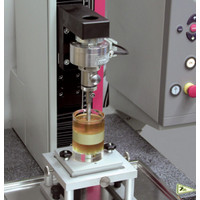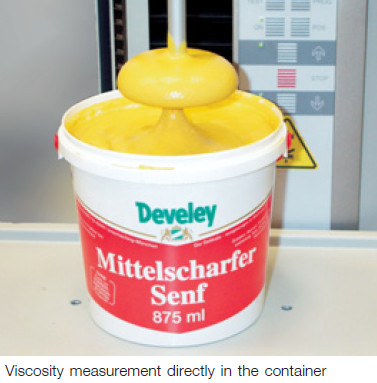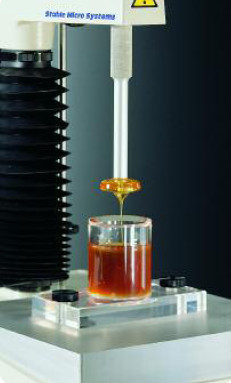
دستگاه بافت سنجی: پروب “بک اکستروژن”
The back extrusion rig – an alternative to
rotation viscometers
آلترناتیو برای ویسکومتر چرخشی
ماست
yogurt
BACK EXTRUSION
از این پروب می توان هم برای اندازه گیری ویسکوزیته (قوام) و هم چسبندگی ماده ویسکوز استفاده کرد.
فراتست عرضه کننده دستگاه های تست
0912-3750274
021-88705040
This rig comprises of a sample container
which is centrally located beneath a disc
plunger. The disc plunger performs a
compression test which extrudes the product
up and around the edge of the disc.
This test measures the consistency of
viscous products such as yoghurt, creams
and sauces as well as processed fruit and
vegetables. Results relate to measurements
of viscosity. Three discs of different
diameters are provided. Usage depends on
the type of product to be tested and whether
it contains any particulates such as found in
soups or jams.
The back extrusion rig – an alternative to
rotation viscometers
With the back extrusion rig Zwick Roell offers an
alternative solution to rotation viscometers.
The principle of the back extrusion rig is based on the
displacement of the test material through an annular
gap between piston and back extrusion cell. The cell is
filled with the test substance and the piston is lowered
into the container, pressing the material up through the
annular gap. When the piston is raised, the material
flows back through the annular gap into the cell.
The force is measured in the down- and up-cycle at a
defined position. The dynamic viscosity is evaluated,
from the measured force difference and the flow rate of
the liquid in the annular gap.
The Zwick Roell system can repeat this cycle as often
as desired with freely adjustable shear rates. Thus the
test can be optimally adapted to your test material, and
with only one single test you can measure the viscosity
across the entire shear range.
:Advantages of tests with the back extrusion rig
• The viscosity can be determined directly in containers
from the running production. This rules out prestressing
of the material caused by transfilling.
• Flow influences which occur in the production plants
can be reproduced by altering the annular gap and
the moving speed.
• This method enables tests on materials with chunky
pieces as fruit preparations and food systems: Fruit
pieces or other bigger ingredients are not pushed
aside and thus are measured together with the yogurt
or the fluid.
• Individual selection of the number of test cycles and
the possibility of increasing the shear rate for each of
these cycles enables recording of the viscosities over
the entire shear rate in just one test.
• The test results on Newtonian fluids correlate with the
results from measurements with rotation viscometers.
For non-Newtonian fluids reproducible, comparable
test results are obtained, usually with more sensitive
characteristics









